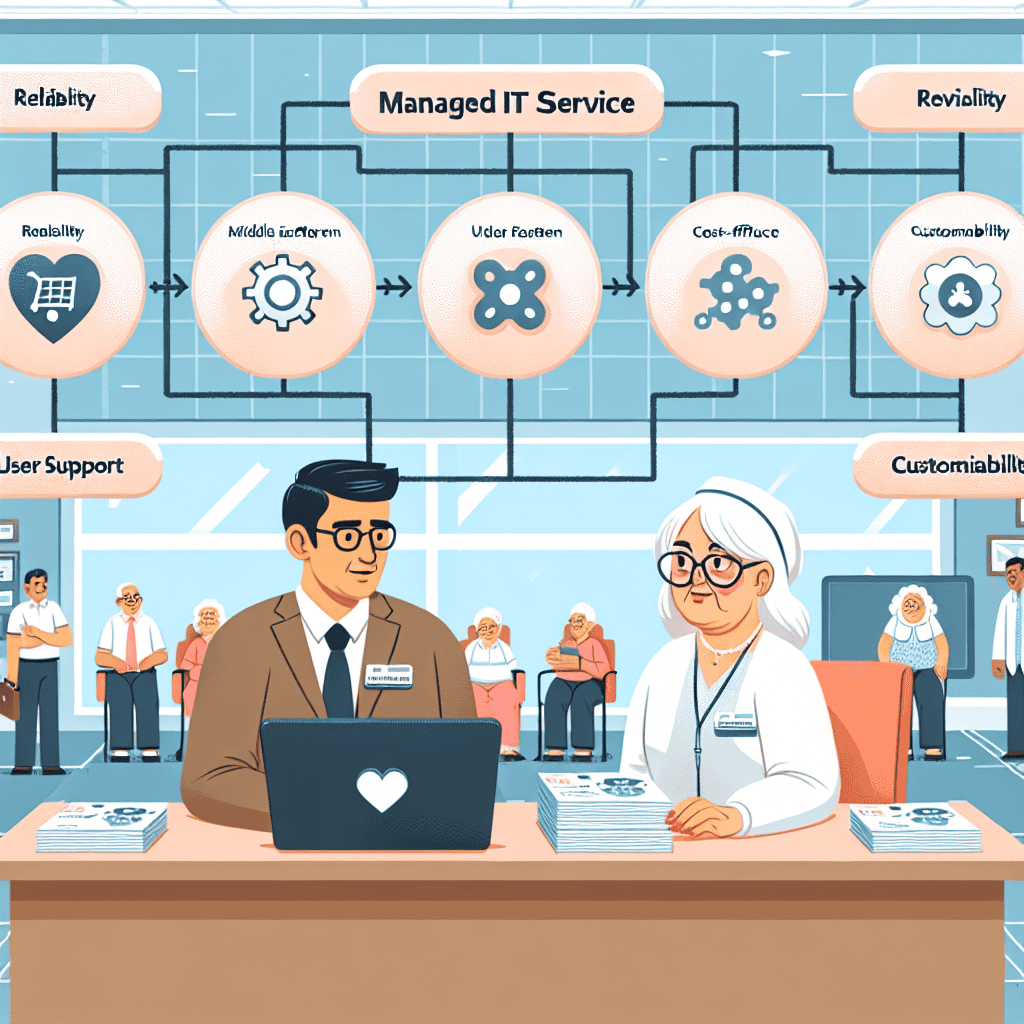Selecting the Right Managed IT Service for Elderly Care Facilities

In the rapidly evolving landscape of healthcare, elderly care facilities face unique challenges that require specialized solutions. One of the most critical aspects of modernizing these facilities is the integration of managed IT services. These services not only streamline operations but also enhance the quality of care provided to residents. However, selecting the right managed IT service can be a daunting task, given the myriad of options available. This article delves into the essential considerations and strategies for choosing the most suitable managed IT service for elderly care facilities.
Understanding the Needs of Elderly Care Facilities
Before diving into the selection process, it is crucial to understand the specific needs of elderly care facilities. These needs are often distinct from those of other healthcare providers due to the unique demographic they serve. Elderly care facilities must prioritize patient safety, data security, and seamless communication among staff and residents.
Patient Safety and Monitoring
One of the primary concerns in elderly care is ensuring the safety and well-being of residents. Managed IT services can play a pivotal role in this aspect by providing advanced monitoring systems. These systems can include fall detection sensors, real-time health monitoring devices, and emergency alert systems. By integrating these technologies, facilities can significantly reduce the risk of accidents and ensure timely medical intervention.
For instance, a case study involving a nursing home in Florida demonstrated a 30% reduction in fall-related incidents after implementing a comprehensive IT-managed monitoring system. This system included wearable devices that alerted staff to any sudden movements or falls, allowing for immediate response.
Data Security and Compliance
Data security is another critical area where managed IT services can make a significant impact. Elderly care facilities handle sensitive patient information that must be protected under regulations such as the Health Insurance Portability and Accountability Act (HIPAA). A robust IT service will ensure that all data is encrypted, access is controlled, and regular audits are conducted to maintain compliance.
Statistics show that healthcare data breaches have increased by 25% over the past five years, highlighting the need for stringent security measures. Managed IT services can provide the necessary infrastructure and expertise to safeguard against these threats.
Communication and Collaboration
Effective communication is vital in elderly care settings, where staff must coordinate seamlessly to provide optimal care. Managed IT services can facilitate this through integrated communication platforms that allow for instant messaging, video conferencing, and shared access to patient records. These tools not only improve efficiency but also enhance the quality of care by ensuring that all team members are informed and aligned.
For example, a facility in California reported a 40% improvement in staff communication and a 20% increase in patient satisfaction after adopting a managed IT communication platform. This platform enabled real-time updates and collaboration among healthcare providers, leading to more coordinated and effective care.
Evaluating Managed IT Service Providers
Once the specific needs of the facility are identified, the next step is to evaluate potential managed IT service providers. This process involves assessing their expertise, reliability, and ability to meet the unique requirements of elderly care facilities.
Experience and Expertise
When selecting a managed IT service provider, it is essential to consider their experience and expertise in the healthcare sector, particularly in elderly care. Providers with a proven track record in this field are more likely to understand the nuances and challenges associated with managing IT in such environments.
Look for providers who have worked with similar facilities and can demonstrate successful outcomes. Case studies and client testimonials can provide valuable insights into their capabilities and reliability.
Service Level Agreements (SLAs)
Service Level Agreements (SLAs) are critical in defining the expectations and responsibilities of both the provider and the facility. A comprehensive SLA should outline the scope of services, response times, and performance metrics. It should also include provisions for regular reviews and updates to ensure that the service continues to meet the facility’s evolving needs.
For instance, a facility in New York negotiated an SLA with their IT provider that guaranteed a 99.9% uptime for their critical systems, ensuring minimal disruption to their operations.
Scalability and Flexibility
Elderly care facilities must be prepared to adapt to changing circumstances, whether it’s an increase in resident numbers or the introduction of new technologies. Therefore, it is crucial to choose a managed IT service provider that offers scalable and flexible solutions. This ensures that the facility can easily expand or modify its IT infrastructure as needed without incurring significant costs or disruptions.
Providers that offer modular services or cloud-based solutions are often better equipped to accommodate such changes, providing the facility with the agility it needs to thrive in a dynamic environment.
Implementing Managed IT Services in Elderly Care Facilities
Once a suitable managed IT service provider is selected, the next step is implementation. This phase requires careful planning and execution to ensure a smooth transition and minimal disruption to the facility’s operations.
Planning and Preparation
Effective implementation begins with thorough planning and preparation. This involves conducting a comprehensive assessment of the facility’s current IT infrastructure, identifying areas for improvement, and developing a detailed implementation plan. The plan should outline the timeline, resources required, and key milestones to be achieved.
Engaging stakeholders, including staff and residents, in the planning process can also help identify potential challenges and ensure that the new system meets everyone’s needs.
Training and Support
Training is a critical component of successful implementation. Staff must be adequately trained to use the new systems and technologies effectively. This includes not only technical training but also education on best practices for data security and compliance.
Ongoing support from the managed IT service provider is also essential to address any issues that may arise and ensure that the facility continues to operate smoothly. Providers should offer 24/7 support and regular system updates to keep the infrastructure running optimally.
Monitoring and Evaluation
After implementation, continuous monitoring and evaluation are necessary to assess the effectiveness of the managed IT services. This involves tracking key performance indicators (KPIs) such as system uptime, response times, and user satisfaction. Regular reviews with the IT provider can help identify areas for improvement and ensure that the service continues to meet the facility’s needs.
For example, a facility in Texas implemented a managed IT service and conducted quarterly reviews to evaluate its performance. This proactive approach allowed them to make timely adjustments and maintain high levels of efficiency and resident satisfaction.
Case Studies: Success Stories in Managed IT Services for Elderly Care
Examining real-world examples of successful managed IT service implementations can provide valuable insights and inspiration for other facilities looking to enhance their operations.
Case Study 1: Enhancing Resident Safety in a Nursing Home
A nursing home in Ohio faced challenges with resident safety, particularly in preventing falls and ensuring timely medical intervention. By partnering with a managed IT service provider, they implemented an advanced monitoring system that included wearable devices and real-time alerts. This system not only reduced fall-related incidents by 35% but also improved staff response times, leading to better overall care for residents.
Case Study 2: Streamlining Operations in an Assisted Living Facility
An assisted living facility in Arizona sought to improve its operational efficiency and communication among staff. They adopted a managed IT service that provided an integrated communication platform, allowing for instant messaging, video conferencing, and shared access to patient records. As a result, the facility experienced a 25% increase in staff productivity and a 15% improvement in resident satisfaction.
Case Study 3: Ensuring Data Security and Compliance in a Senior Care Center
A senior care center in Illinois was concerned about data security and compliance with HIPAA regulations. By engaging a managed IT service provider with expertise in healthcare, they implemented a robust security infrastructure that included data encryption, access controls, and regular audits. This not only protected sensitive patient information but also ensured compliance with regulatory requirements, giving the facility peace of mind.
Conclusion: Key Takeaways for Selecting Managed IT Services
Choosing the right managed IT service for an elderly care facility is a complex but essential task that can significantly impact the quality of care provided to residents. By understanding the specific needs of the facility, evaluating potential providers, and implementing the chosen service effectively, facilities can enhance their operations and ensure the safety and well-being of their residents.
Key takeaways include the importance of prioritizing patient safety, data security, and communication; evaluating providers based on experience, SLAs, and scalability; and ensuring successful implementation through careful planning, training, and ongoing support. By following these guidelines, elderly care facilities can leverage managed IT services to improve their operations and provide better care for their residents.





